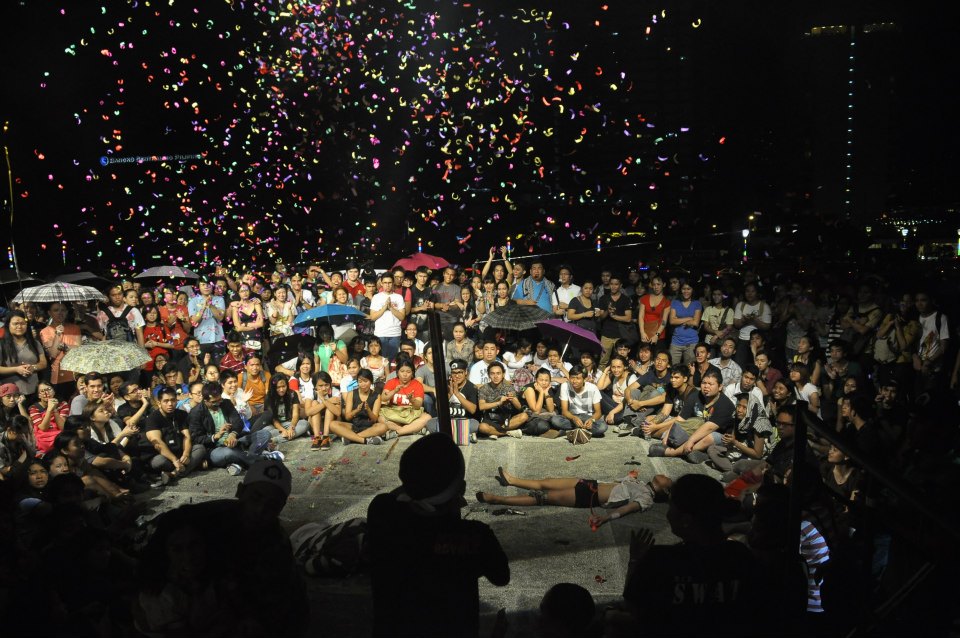Connecting with Communities and Bringing Audience into the Process of Creation
Yamaguchi: The members are highly motivated. From where does the energy come?
Sarah: I think we are enthusiastic about working together and with strangers using performance as a platform for exchange. One of our members, Meila, who has experience with the Steiner Method, taught us that the children, audience and participants are the curriculum. Our work is to explore relationships with communities, site-specific creations outside of theaters, and collaborations with people who are there. As members of the society, we interact not as artists and audience, but as people. We collaborate as members of a community in the society. Through this point of view, our activities and performance programs have developed.
Yamaguchi: What effects or changes have those activities brought about in the local people?
JK: As artists, we have responsibility to understand the situation that surrounds audience. There are political, economical and cultural contexts, and we find a point of contact there. What we think theatre can do is creation of a platform where local people get together to raise questions and exchange. If you see performance as a tool for making something possible or a rehearsal for a life, exchange through it gains meaning, and production methodology changes.
For example, we have recently employed a "blank ticket system." You see a show, and you decide the price of the ticket within your affordability, based on your evaluation of the show. For a student, 100 pesos or two dollars is a price for a meal. Someone tells us that he can pay only 100 pesos because he is a student but he will support us in the future if he finds a job. This is very important for me, because we establish friendship this way.
Sarah: I think the change has been occurring steadily. I remember that street children were seeing the first performance of Battalia Royale from a distance. They were very much intrigued, wondering what we were doing, although it was not really for children. They came to us after the show and gave us some coins. That was really an overwhelming experience for us. They spontaneously paid for a performance that is not as necessary for survival as food is.
There's something there that Sipat Lawin wants to communicate.
Yamaguchi: I think there are various types of communities. How do you approach them?
JK: We consider each situation. We have workshopped in a village and shared a creation process for months with children and teenagers. We employed rap battles and hip-hop technique competition, and as the result, we had a Romeo and Juliet. We started with 25 people, and finally 50 people performed in it. With a basketball court as the stage, we used a balcony, and the audience ran with us seeing the performance. Witnessing the energy, we came to think that it is not that people don't want to go to the theatre but that we didn't open the door to them enough. It is important to deliver theatre to them instead of bringing them to the theatre. This awareness made us shift our mind.

Sarah: We shifted to a language that enables connections.
JK: The audience's point of view is important both in creation process and presentation. We also need to understand the dynamics of online communities that a lot of people take part in, which is another example of the linguistic shift. Battalia Royale was called a "Live Action Game" instead of "performance" or "theatre," which opened the door to game fans, people with scientific backgrounds, and IT workers. Audience who were new to theatre involved themselves in the story development. Theatre expanded itself, and the dynamics of performance was expanded too. After that, we continued to explore how to involve audience, and created the next piece Love through crowdsourcing, to which everyone could contribute stories, poems or texts.
Sarah: Or emails or photos. Powerpoint presentations or tweets. Anything.
JK: Everyone has something about love. We collected them and created a piece out of them. How many did we collect?
Sarah: I think around 500 contributions from 200 people.

JK: We created a performance out of that: a myth about contemporary love made from the texts we collected. We used the word "crowd," which spoke for our linguistic shift: crowdfunding and crowdsourcing. We were connected to many people that way.
Recently social media are the craze among people, and there are a lot of noises online, so we took a handcraft approach next and created a performance with one performer and one audience. It was a shift from a large-scale thing to an intimate show. We have always been exploring how to connect.
Yamaguchi: You create in various ways, which is interesting.
Sarah: After that, in a music festival, we had "One-on-One Concert." One musician and one audience.
JK: Music festivals are so crowded and noisy. Sometimes you want to listen to music quietly. So we organized it.
Sarah: Someone is standing on the corner. You approach the person, and s/he says, "Thank you for coming to my concert." S/he actually sings there, or whispers sometimes.
JK: Though it was hard to find musicians (laughs).
Battalia Royale, a Performance Inspired by a Japanese Film
Yamaguchi: How was Battalia Royale conceived? I'd like to hear in detail about the process.
JK: The piece is very loosely based on Battle Royale, the novel by Koshun Takami. In 2003, when I was a high school student in Osaka, I saw the film based on the novel and was very much impressed. I am from the Philippines and didn't share the cultural background, but I found something immediate. I kept thinking about that. In 2009, an Australian writer David Finnegan contacted me, and I presented his piece in a restaurant. After that, he asked me about my future plan. I said, "I have a lot of ideas, I teach two student's theatre companies, and I'm going to launch Sipat Lawin, but the only thing that I really want to do is Battle Royale that I had seen and read in Japan." Then he said, "Well, actually I wrote a text based on Battle Royale." That was so-called synchronicity. David said that he wanted to present it for 11 days with 11 performers and 11 playwrights, where someone would die every night. The setting was quite different from the original, but the fundamental idea was kept. Finally he brought three playwrights to Manila.
The biggest concern was that there were three different cultures in the production: the original was Japanese, the playwright was Australian, and the performers and audience were Philippine. I knew a bit about Japan, since I had stayed there for a year, but David knew almost nothing. All the performers were from the Philippines. We had a lot of workshops, studied the novel, and rehearsed with ten performers. The playwrights proposed various scenes, where a confrontation leads to emotional explosion or friendship is built. The playwrights saw the performers playing the scenes, and then revised them and continued writing.
Sarah: Through improvisation.
JK: Yes. They saw their improvisation and wrote the scenes down. Eventually we almost discarded the original story and newly created. The workshop in Manila lasted for three weeks. That was in 2011. On the Christmas in the year, I received the bulky script from the playwrights who had returned to Australia.
Yamaguchi: It was a Christmas present.
JK: Yes (laughs). I read it and thought it was not the way Filipinos would feel. I realized again that it would be about how to translate the Japanese original idea and the Australian taste into a performance in the Philippines. We needed a lot of ideas and inventions, but didn't have enough time. So, to develop the stories, the playwrights proposed that we would create a Facebook account for each character and assign the accounts to the 40 performers who came from various backgrounds including the student's theatre companies.
Sarah: Social media was suitable for creating specific characters.
JK: For example, we would upload photos of the last dance party in one's high school life, childhood or family. Of course everything is fiction. The performers took part in the process of character development. Facebook is considered a marketing tool, but we used it to develop stories for the performance and help audience get the idea. We had a good start for the performance.
Sarah: They had been watching the online performance before coming to the show.
JK: Audience interpreted the stories in their own ways: "What? They can't be friends, because on Facebook they said..." or "Oh, the mother would cry if she knew, because she was making an egg sandwich."
Sarah: Or, "Why are they killing each other? They shared the donuts last week!"
JK: It turned out to be a rich storytelling. Audience filled the blanks of the stories.

Yamaguchi: What kind of space was the venue?
JK: It was premiered on the promenade of the Cultural Center of the Philippines, the slope to the entrance of the theater. A cultural center should be accessible to citizens, but the Center was built on a height, which was the idea of the mayor at that time, and you need to drive a car to reach there. Besides, the rental fee is very expensive. But they allowed us to perform outside, so we used the space. To our surprise, 250 people came to the premiere, 450 to the second stage, and 900 to the third. It became an uproar, so we moved to an abandoned school and took safety measures. In the new venue, audience would keep running together with us.
Sarah: We moved when the scene changed, so audience followed us carrying food and drinks.
Yamaguchi: It sounds like fun.
JK: The script by the Australian writers was full of violence and blood, but as the artistic director, I added humanity and depth to it. You don't kill just because you want to kill. Why do you become violent? Is it the system that makes you violent? Everyone is a victim of something, driven by a situation where you have to win.We once stopped the performance suddenly and asked audience to vote whether to let Timothy, who was standing in the center of the stage, live or die. They screamed, "Die!" or "Live!" This kind of argument was active on the Facebook group too.We also provoked audience by having them vote whether to stop the show or not. "Already 28 people have died. Do you want to stop the show here?" The show would have stopped if more than two-thirds of them agreed. Audience was to decide how to conclude the show. We had a huge argument about this, and we also talked with psychiatrists. Elder theatre people asked us, "Who is responsible for the creation?" We explained that we consider theatre a platform for discourses and use diverse frameworks.
Sarah: Instead of mere post-performance talks and discussions.
JK: We didn't have the answer. Why do you go to see the show? Why are you allowed to kill people in the performance? When going to the show, do you put your moral aside, somewhere outside of the theater, and become a totally different persona? Do you accept this much violence? We kept asking these questions. Perhaps you find a hope for humanity in these questions. Anyway, we think that theatre is a place for people to practice something.







